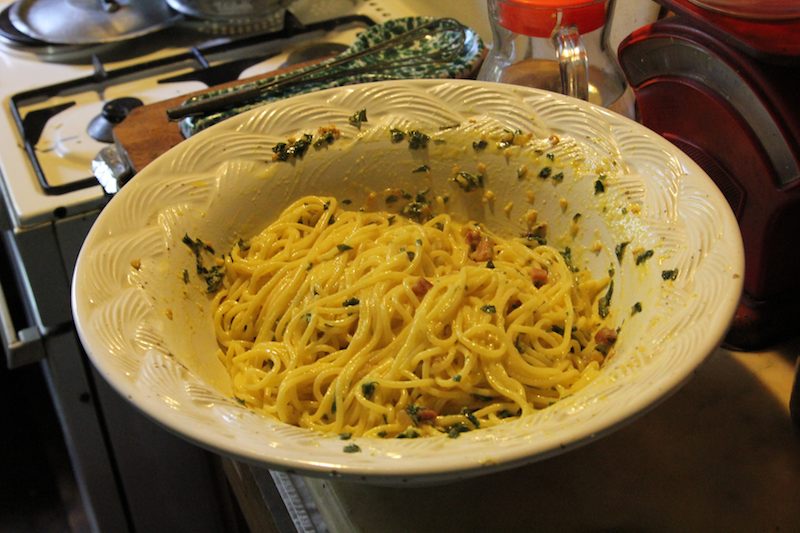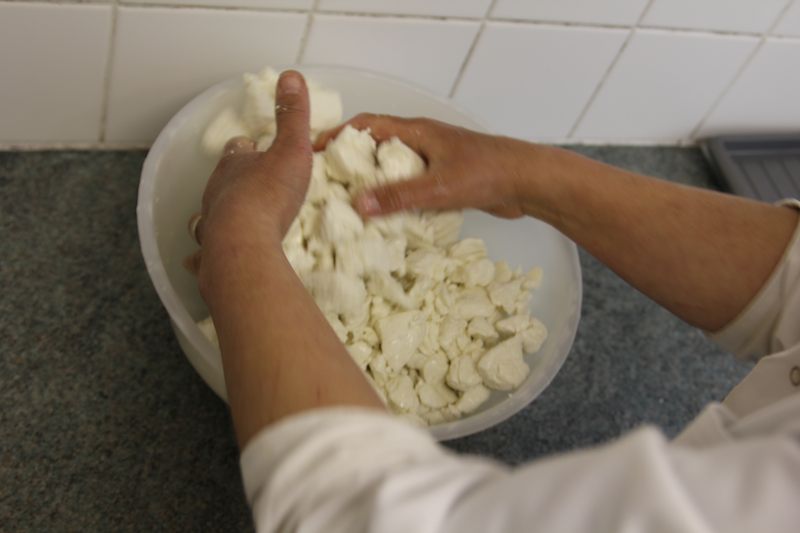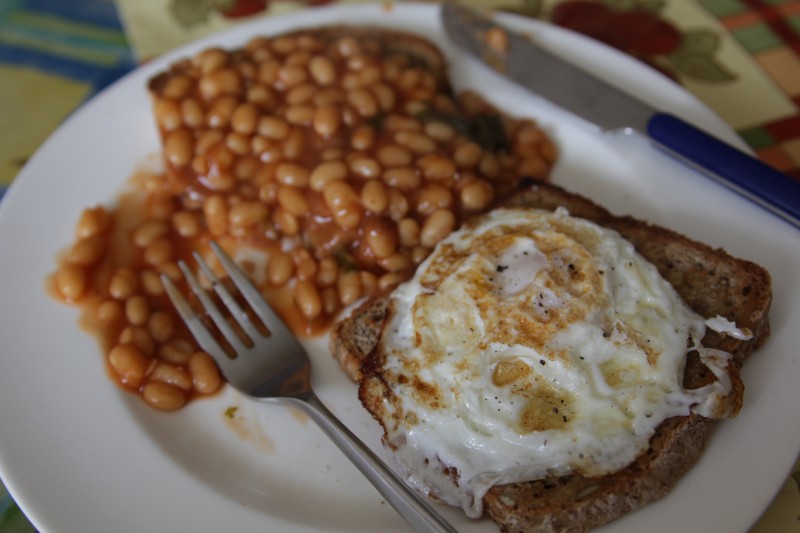Posted: August 31st, 2010 | Author: Halbe | Filed under: Italy, Recipes, Tuscany | 3 Comments »

In Italy, I’ve been cooking a lot more than other places. The best part is that I’m actually learning how to cook better which was one of my goals for this trip. So, for Devon’s birthday I set out to cook him a scrumptious meal. He wasn’t in the mood for a pasta with tomato sauce because we’d had a lot of that. He wanted carbonara instead – a pasta with an egg sauce.
My dad makes a great carbonara pasta so I just tried to re-create that. The result is the above pasta. When Devon, our host Ugo, and I sat down to eat my creation Devon and I were pleased. But, our host had a small suggestion. “For me,” he said, “this pasta is overcooked. The Italian way is to make it more al dente.” I thought I’d done that, but according to our host it still wasn’t the Italian way. So I asked him how it was done “the Italian way.”
He told me, the trick is to take the pasta out of the water before you think it’s ready. When you cook pasta you normally taste is until you think it’s soft enough to plate. In Italy that’s too late. You should actually take it out while it’s still a little on the hard side, just a little harder than you’d want it in the meal. The reason for this? The pasta continues to cook in the hot water while you get your colander ready, it cooks in the colander while it’s draining and it cooks in the bowl while you’re mixing it with the sauce. By the time it hits the table, it’s perfect.
I took his notes and applied it to our pasta the next day (making another dish my dad cooks). When I asked Ugo if the pasta was cooked more appropriately this time, he said, “Oh, I didn’t even notice. That means it’s good!”
Success!
For foodies out there, here’s the recipe for the carbonara I cooked. Note, I did this without a recipe, so the portions are not set in stone. If you want more prosciutto, parsley or parmesan just add it. It won’t kill the dish. It’ll just make it better:
Serves 4-5
1/2 a package of spaghetti (one of the smaller boxes or bags)
2 tbsp EVO
4 raw eggs
1/2 cup – 1 cup finely grated parmesan (depending on your taste)
1 cup fresh Italian parsley (English parsley will do as well)
6-7 slices of prosciutto (it’s kind of to taste, so you can do more or less)
4 cloves of garlic
Instructions:
1. Put a large pot of salted water on to boil (obviously, add pasta when it comes to a boil)
2. While that’s heating, finely chop the prosciutto, garlic and parsley.
3. In a small to medium sized frying pan, saute the garlic over medium heat. Move it around a bit so it doesn’t burn.
4. After 2-3 minutes, add the parsley and prosciutto to the garlic and EVO and saute all together until the prosciutto is cooked.
5. Meanwhile, find a large serving bowl (what you’d like to serve the pasta in) and crack the 4 eggs into it.
6. Mix the parmesan in with the eggs and beat together.
7. Once the pasta is almost ready to be strained add the prosciutto to the egg mixture.
8. Strain the pasta and without washing it add the hot pasta to the egg mixture. Mix all together fully. As the hot pasta mixes with the egg, it’ll cook the egg onto each strand of pasta. Timing is of the essence so don’t let the pasta cool and especially don’t wash it with cool water.
9. Serve with a green salad and crusty bread, if you’re so inclined.
P.S. Message to dad – you’ll probably go and look in your recipe book for this dish now and see my portions are a bit off, but it’s the best I could do while in Italy without your cook book and guidance 😉
Posted: June 15th, 2010 | Author: Devon | Filed under: England, Recipes | 8 Comments »
The first farm we stayed at, Riverside Goats’ Cheese, made two varieties of goat cheese: a fresh cheese with herbs, and an aged cheddar-style cheese.

Yes, that’s mold, but the good kind. This hard cheese is white, with a smooth, mild flavor and a slight earthy tang. This particular specimen is three months old.
I’d never had cheddar cheese from a goat before. I’d always assumed it was a strictly cow thing, and orange like the Tillamook bricks I’ve had all my life. I learned cheddar cheese takes its name from the town of Cheddar, where it has been made for over a thousand years. The “cheddaring” process developed and used there can be applied to kinds of milk beside a cow’s. While we were there, our host prepared a new cheese from scratch.
First, extract a bit of the ol’ goat juice. If I’ve learned one thing about milking a goat it’s that you need to squeeze harder that you may initially be comfortable with. In the words of this farmer, “Don’t worry, you wont hurt them. The kids use their teeth.”
The milk is filtered, then added to a temperature-controlled stainless steel vat. The temperature is raised to around 29 degrees Celsius (84 Fahrenheit). Several grams of a starter culture is added. This is a freeze-dried bacteria of a very particular strain. It looks like flaky, yellow-ish powder. It’s called a “starter” because it starts the cheese.
Stir it in, and let that bacteria multiply in there. The acidity of the milk will begin to raise, which is a good thing. That is a result of the bacteria, and it helps ensure that ONLY good bacteria exists in the milk, and not the kind that can make you violently ill.
Rennet is then added (20 drops or so to the 25 liters of milk we’re using to make this single cheese). Rennet is a combination of enzymes, traditionally extracted from the stomach of mammals (cows, usually), used to digest milk. In cheese making, it coagulates the milk, separating it into the solid stuff used to make cheese (curds) and the liquid (whey).

Within an hour, the milk became custard-like, with a watery liquid covering it. Then comes the fun part: cheddaring.

A “cheddaring knife” (six dull blades held in parallel) is passed through the curds and whey, dicing it up. The size of those diced chunks of curd affects the ultimate texture and taste of the cheese. The goal is to create surfaces inside the curd for the whey to seep away. Too large, it may become lumpy with veins of mold running through. Too small, and the result may dry and become crumbly. She spent a lot of time ensuring the entire vat was cheddared consistently, and no large chunks remained, especially on the bottom.
You then allow the whey to seep from the curd, then drain that whey away.

You leave those curds to drain again, then cut them again. Drain again, then cut again. Then, finally, drain again. The consistency will become drier on each pass, from custard-like, to soft wet tofu, to hard tofu.

The curds at this point is chewy and fairly tasteless. The flavor of cheese tends to come from the bacteria that inhabit it, and develops over time, as that bacteria consumes proteins and sugars in the curds. But before that happens, the curds are milled (broken up by hand) and salted.

The salt helps the flavor. I read recently that salt functions to open up the tastebuds, to allow in flavors that otherwise would be missed by the tongue. The salt also acts a preservative. Also, thanks to the culture, the pH should have dropped to 5.4 or so — acidic enough to keep bad bacteria at bay.
But this bowl of curds is not cheese yet. First it must be drained more, but in a controlled fashion that limits the loss of the protein-rich curds. For that, cheese cloth, a form, and heavy wood blocks are used.

The salted curds are packed into a cylindrical form with holes in it (for drainage) and lined with cheesecloth. Round wood blocks are placed atop it, slowly squeezing the whey out.

Additional blocks are added as the curds are squeezed down. Cheesemakers tend to use the same blocks. The thought is that a bacterial culture unique to their cheesemaking operation lives on the surface of those wood blocks which adds a unique flavor to their cheese.
The contraption in this photo is a spring-loaded squeezer that applies a delicate downward pressure. Too much pressure, and you squeeze out too much moisture. Not enough, and it can rot. The draining can take a full day, or more. Once drained, you extract your squeezed, round-shaped block of curd which is looking more and more like cheese. This particular cheese is only half-drained. It still had more time to go.

Look how small it is compared to the initial vat of milk. Once drained thoroughly, you extract the cheese for the last time from the form and cheesecloth, then set it on a shelf in a cool, ventilated room.

After a few days a fine white mold will cover the cheese. Here is our cheese, about two days old. This mold is a good thing, as it helps hold in moisture, necessary to the bacteria inside. As time passes, other molds may form (as can be seen in the first photo on the three-month cheese). If it gets too nasty, you can wipe the excess mold off with a damp cloth.
For this particular variety of cheddar, there’s not much to do now but wait for the flavor to develop to the desired sharpness. There’s many other things one can do, from poking tiny holes hrough the block so mold can grow inside (as seen in blue cheese), to placing it in a bath of brine. There are hundreds of cheeses out there, and a different method for each.

Posted: May 25th, 2010 | Author: Devon | Filed under: Ireland, Recipes | 11 Comments »

The highlight of my trip to the Guinness Storehouse was the “Perfect Pint” bar, where they instruct visitors on how to pour, you guessed it, the perfect pint. They’re very specific about it, largely to ensure the correct amount of the creamy head. I took copious notes (not really, I photographed the instructional poster), and here is the method as described to me by an official Guinness bartender:
- Take a cool, dry, Guinness-branded glass. The distinctive, bulbed pint glass is important. The traditional, straight-side glass leads to either too-much or not enough head.
- Hold the glass “firmly” at 45 degrees under the tap, logo facing you.
- Pull the handle fully forward towards you. Straighten the glass when the drink reaches the “Guinness” text. Stop filling when it reaches the middle of the harp, or about 3/4 full. Do not allow the nozzle to touch the side of the glass, nor penetrate the surface of the drink.
- Leave the surge to settle, allowing the creamy head to form. The head should be 10-15 mm high. The head is formed by nitrogen gas, released from the liquid by friction from a mid-line filter. It first runs down the side of the glass (hence the cascading dark/light effect), then up the middle. The gas, temporarily caught in the top of the liquid, forms the head.
- Top up the glass by pushing the tap handle away from you. Stop when the foam is proud of the rim (slightly above it). Do not allow spillage.
- Present to customer with a steady hand, logo facing forward.
There. Now that’s a perfect pint.
Posted: May 4th, 2010 | Author: Devon | Filed under: England, Recipes | 4 Comments »
Hearty and quick. Bread was made yesterday (wheat flour, salt, yeast, walnuts, water). Eggs were from our hosts’ hens. Butter was from Devon county cows up the road. Beans, well… they’re Heinz, but stewed with a few items from the garden. All in all, a pretty locally sourced meal, and I’m told one that is very traditionally British.

After, I had a “barley cup,” a hot beverage made from roast barley and milk. It’s considered an alternative to coffee (a result of the rationing in Britain during WWII) but has no caffeine. It tasted like well-roasted (maybe even slightly burned) wheat. Not bad, actually. Very wholesome.

Posted: April 29th, 2010 | Author: Halbe | Filed under: London, Recipes | 9 Comments »
Devon and I made it to London, finally! We flew in on Monday afternoon and worked to keep our eyes open (man, it was rough) after having dinner with our family friend hosting us. We planned our day in London that evening and were off by 10 am the next day to have a full day exploring. We touched on quite a few biggies on that first day including, but not limited to:
Westminster Abbey
Houses of Parliament
London Bridge
Big Ben
Piccadilly Circus
Covent Garden
St. Paul’s Cathedral
Temple Bar
But, the meals, what about the meals (Fred, this is for you)? Well, our first meal in London was actually a dinner at an Italian restaurant which isn’t actually worth blogging about. But, my daily breakfast is – traditional porridge. Our host, Michael, makes porridge with raisins and milk every morning and it’s delicious. So, here’s what it is and how he makes it:

Ingredients: Oats (probably the minute kind), 2% or whole milk and raisins
How to make it:
Michael does something interesting, he allows the oats to soak in the milk for an hour or so before even cooking it (it makes the oats so soft) so that’s the first step. Soak the oats in milk in the pot for 30-60 minutes (ratio of oats to milk is 1:4). Next, add raisins and light a medium to high heat. Let the oats and milk cook for 15-20 minutes while stirring constantly, until thick and you’ve got porridge! So, delicious we don’t even use sugar. Now, that might be because the milk tastes different here but, it’s very, very tasty and not quite the same as oatmeal. It’s better!
After our breakfast with Michael, Devon and I usually have lunch in London and it’s not anything to write home about. In fact, our first lunch was at a traditional English pub. Devon ordered fish and chips, which he was were “pretty good” and I ordered a ham and mustard sandwich.
 When I got the sandwich I was disappointed to discover that the British use butter instead of mayo. My sandwich had one slice of rubbery ham, butter on both sides and seedy mustard all between two unimpressive pieces of a nutty, whole wheat bread.
When I got the sandwich I was disappointed to discover that the British use butter instead of mayo. My sandwich had one slice of rubbery ham, butter on both sides and seedy mustard all between two unimpressive pieces of a nutty, whole wheat bread.

I only ate half of it – it wasn’t good, to say the least. My lunch was mostly the chips that came with it. So, I’ve discovered now why England isn’t known for it’s authentic food. But they are known for their Indian food and for a good reason. The only meal that’s even worth discussing was an Indian meal we had this evening in a town outside of London with our host. Indian food is the safest type in these parts. Go figure.
Next up: Goat cheese in Crediton. Yum!

















